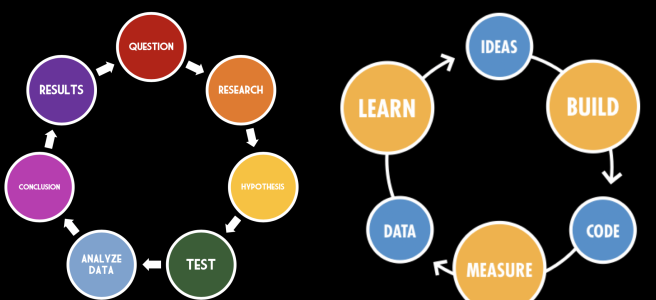If you practice Lean Startup methodologies, you’re likely familiar with Build-Measure-Learn. It seems like the directive here is to first build something quickly, then measure some results, and then try to learn, all as quickly as possible. The problem is that too many people have taken this literally, building without first pausing to articulate what they think they know about their business and customer, and what it is they want to learn next.
What we actually need to do is Learn-Build-Measure. In other words, think first about what you already know about your business and customer, then form a testable hypothesis to validate, and then move on to building and measuring.
Now you might be thinking, “But it’s a loop, so why should it matter where we start?”
It matters because building without some reasonable understanding of your business and customer is just guessing. And if you’re guessing, you’re in the realm of superstition rather than science.
Building without an understanding of your customer is superstition, not science. – Tweet This
Unless you’ve put some serious thought into testing hypotheses, running experiments, and applying Lean Startup methodologies, it’s likely that you’ve been guessing about the results of your experiments rather than learning from them. Every time this happens, you lose a valuable chance to validate and improve your understanding of your business and customers, and you waste time and money.
Writing a good hypothesis is hard, but it’s worth the effort. A good hypothesis makes it easy to design an experiment to test and learn from it—by making clear what it is you are validating or invalidating—usually your current understanding of your business and customers.
A proper hypothesis is an educated guess—just like we learned in our science classes growing up. What I see most often, though, are merely guesses: spaghetti on the wall and shots in the dark. How could this be happening, with all of our understanding of Lean Startup, and of science?
The Lean Startup Build-Measure-Learn loop is really an application of the scientific method. Check it out (slide 24 from that presentation, which touches on several Lean Startup practices):

This means that we need to use care to ensure we take our learnings and shape them into new ideas and generate new hypotheses.
The Lean Startup Build-Measure-Learn loop is an application of the scientific method. – Tweet This
Many people are unable to clearly articulate their current understanding and assumptions about their business and their customer. If you are unable to clearly articulate these and you are trying to run experiments, it’s a red flag. It’s probably better to start with developing a better understanding of your customer than running haphazard experiments.
Here is a template to use for crafting hypotheses that you can learn from, and hopefully help clarify whether running an experiment is the next right step. If you can write a proper hypothesis, you’re probably ready to run an experiment. I’ll start with this simple version:
Because we believe X, if we do Y, we expect Z to happen.
Writing a hypothesis with details about your business requires a solid understanding of our business and customer. We must assert something about what we know, or have already learned that we can then validate. This is true validated learning.
Let’s add more detail using a lemonade stand business as an example and get one step closer to having a hypothesis we can validate:
Because we know our customers prefer colder lemonade in warmer weather, if we add ice to each cup of lemonade we sell, we expect higher customer satisfaction and more sales.
I like to go even further, adding an assessment of the potential outcomes to the experiment plan. This gives you a better idea of why you’re running the experiment in the first place, forces you to think about how you’ll use what you learn, and importantly, forces you to consider some of your assumptions:
If we are correct, we would also expect that customer surveys would also validate a preference for ice, that we might be able to run tests to find the quantity of ice that maximizes sales, and that our Net Promoter Score would increase. If we are wrong, it might indicate that customer preference for cold lemonade might be influenced by other factors such as the precise ratio of ice to lemonade, the exact temperature outside, the quantity of sugar, lemon juice, and water in our recipe, or the price of a drink from your competitor down the street.
This assessment is crucial, and perhaps the hardest part of running an experiment as it reflects the thinking behind the experiment. Good experiments require thoughtful planning up front, even when practicing Lean Startup methodologies.
Good experiments require thoughtful design, even for a lean startup. – Tweet This
Even our simple example exposes many factors that might affect experiment design and results interpretation. Taking time to think, articulate what you know, and expose your assumptions while forming a proper, testable hypothesis will help you do truly validated learning, and help you to fulfill the promise of the Lean Startup.



